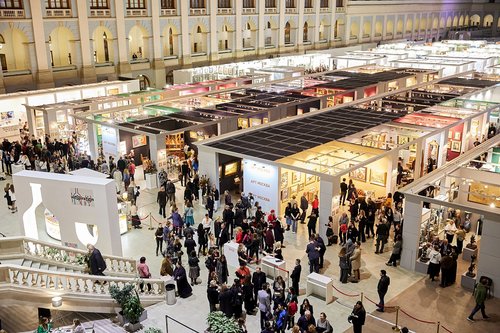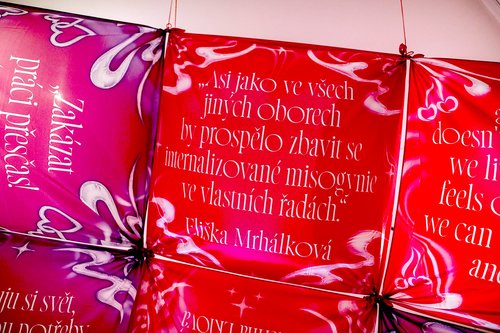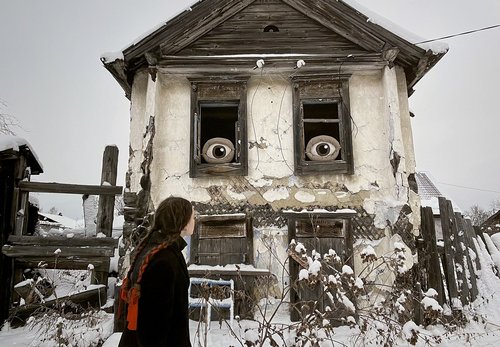The Feminine Face of Russian Contemporary Art

Tatiana Antoshina. No. 6, from the series 'Space Travelers', 2009. Courtesy of the artist
In a field which was once almost entirely male, over the last decade the face of contemporary Russian art has become resoundingly female and nowadays no serious exhibition either in Moscow, St Petersburg or Ekaterinburg is considered complete if it does not feature works by young women artists.
Feminist art as a phenomenon has taken shape in Russia only over the past decade, as female artists have increasingly gained visibility. During the noughties women accounted for the majority of art school students and graduates and some believe that Russia’s socio-economic conditions in the 1990s have played a role because the financial hardships of perestroika meant that boys who had been born in first decade of the 21st century were encouraged by their parents to choose more stable professions. The nineties was a decade in general where artists (both female and male) in Russia began to explore new frontiers in their work, artists like Lyudmila Gorlova (b. 1968), Tatiana Antoshina (b. 1956), Irina Waldron (1957–2023), Elena Kovylina (b. 1971), or the artistic duo ‘Factory of Found Clothes’ aka Olga ‘Tsaplya’ Egorova (b. 1968) and Natalia ‘Gluklya’ Pershina-Yakimanskaya (b. 1968) all broke away from previous moulds. Yet there is a sense that those female pioneers in the field have been followed by a new crop of young female artists more content to settle for the niche of ‘women's art’ as it had been first defined by their predecessors. With an awareness of institutional quotas within the genre, have things gone too far?
Today in Russia there is now a vast crop of very young contemporary artists both male and female showing just how much the gender field has balanced itself out over the past few decades, and how much easier it is today for the current generation of female artists to get ahead in their careers than it was for those who came before them. Graduates of the Academy of Art and Industry in St. Petersburg have managed to integrate traditional, professional skills into contemporary art and young female artists are excelling in gender marked media such as watercolour, ceramics, and textile art – including embroidery, knitting and weaving - and producing work which demonstrates great creative and individual depth. And now female artists are freely exploring expressive abstraction, with a preference for styles and themes far from academic conservatism which even suggests a kind of collective state of rebellion.
Street art has long been considered a form of radical rebellion. Two very different artists from St Petersburg who are working in this field and are outstanding, are vandalizy and mvpicture. Not long ago both had to leave Russia for political reasons. Performative genres in which women have traditionally played the most prominent role almost came to a halt after February 2022, when female participants in protest performances and art activists began leaving the country or otherwise ceased their public activities.
No longer considered to be a secondary art form, watercolour as a medium has gained scale, depth and a more cohesive language in the work of many female artists. There are some notable artists in this field from the St. Petersburg school who now continue to work actively outside Russia such as Asya Marakulina (b. 1988) who now lives in Vienna, and Veronika Ivashkevich (b. 1992) in Warsaw.
Ceramists also became part of the Russian contemporary art scene in the 2000s, led in part by Daria Krotova-Schlosser (b. 1971), who has long lived and worked in Europe, and a new generation includes Moscow-based Svetlana Mamontova (b. 1991), who interprets the aesthetics of pop art and mass culture and Oksana Afanasyeva (b. 1987), who inclines towards the confessional and lyrical form. Art that is closely related to what was once considered the applied arts is seen as a form of free creativity like sculpture and is popular among young female artists. The craft of weaving is best represented by Zhenya Machneva (b. 1988), who currently lives in France who exhibited at the 2022 Venice Biennale. And embroidery is even more popular among Russian artists, one particularly strong practitioners of this genre is Anna Bat (b. 1986), who creates multi-page livres d'artiste on fabric with embroidered illustrations and text.
There is a deep desire among today’s young female Russian artists to defend their autonomy of expression, to produce art that denies the totalitarianism of ‘big narratives’ and focuses on the fragility of the inner world often ignores important contexts of general significance. Two major preoccupations in women's art today, corporeality and the problem of self-identification, are so much in demand now that in today’s artistic environment approaches and techniques quickly evolving and then becoming anachronistic. One artist who appears to be in touch with the times is Polina Uvarova (b. 1996), whose obsessive diary-style drawings can now be seen in her works on metal plates.
Over the past decade, as young Russian artists have begun to explore authentic folklores often connected with notions of the underworld, the interest in Russia’s many distinctive cultures has hardened into an ideology of ‘national exceptionalism’. Artists working with folkloric themes today are expected to show a strong personal connection to local identities. This is true of the works of Polina Osipova (b. 1998) an artist and fashionista who moved from St. Petersburg to London, where she continues to explore her Chuvash roots and to Alisa Gorshenina (b. 1994), who now lives in Nizhny Tagil but whose work draws on her roots in the small Russian village of Yakshina in the Urals.
The notion of ‘Magiciens de la Terre’ has been around since Jean-Hubert Martin’s exhibition at the Pompidou in 1989, but the concept has shifted into a female domain. Here the entire magical spectrum is represented, from a fascination with witchcraft as feminist in its liberating rituals, the use of found natural materials, to deep immersion in the lives of fictional female characters. Daria Pravda (b. 1981) is well known for her works ‘Charovers’ and ‘Torus Society’, representing an alternative history of women's studies and gender emancipation in Russia.
It is easy to find feminist attitudes in the diverse creative practices of Russian female artists: their rejection of violence in the broadest possible sense, their opposition to hierarchies, as well as their desire for horizontal networks and connections. These artistic gestures have a certain softness in which any certainty or clarity of form can be seen as a manifestation of violence. If there is often a gap between professional skills and a consciously sensitive approach to a subject or the material, it is hard to distinguish. While in Europe and America there is talk of the end of the ‘fourth wave’ of feminism, in contemporary Russian society all these ‘waves’ are present simultaneously: it is a complex picture. Creative strategies are mixed in with ideological tactics as Russia’s female artists take every opportunity to promote their art and to be heard.





















